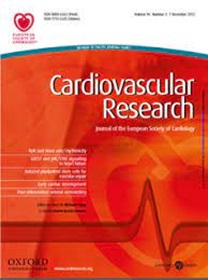Impaired coronary flow reserve by hyperviscosity in a mouse model of non-light chain multiple myeloma – a mechanism of coronary flow impairment at the capillary level
IF 13.3
1区 医学
Q1 CARDIAC & CARDIOVASCULAR SYSTEMS
引用次数: 0
Abstract
Aims Multiple myeloma (MM) is associated with cardiovascular risk, although the exact underlying mechanisms are unknown. Here we tested the hypothesis that MM impairs coronary flow reserve due to increased blood viscosity caused by elevated monoclonal protein concentration. Methods and Results In a mouse Vĸ*MYC model of non-light chain MM recapitulating all aspects of human disease we showed that the disease progression was associated with progressive increase of blood and plasma viscosity. Using intravital microscopy imaging of ex vivo stained red blood cells we observed reduction of coronary flow reserve (CFR) in vivo with the CFR limiting site being coronary capillaries. This was further confirmed by similar coronary flow profile in mice with hyperviscosity induced by acute hyperlipidemia and disappearance of this MM-related CFR impairment in saline perfused ex vivo hearts. Of note, nitric oxide production in vivo was increased in the coronary circulation, especially at the capillary level, but the systemic concentration of nitric oxide metabolites was unchanged, again supporting the hypothesis that increased blood viscosity is the main culprit here. Moreover, MM progression was associated with progressive impairment of left and right ventricular function, but without histological signs of myocardial deterioration, hypertrophy or fibrosis. Conclusion Our study shows a potentially completely new mechanism of cardiovascular adverse effects caused by MM or more broadly by hyperviscosity syndromes, i.e., CFR impairment at the capillary level. Since capillaries, unlike larger vessels, cannot be recanalized or dilated, completely new preventive approaches are needed, such as agents affecting blood rheology.非轻链多发性骨髓瘤小鼠模型的高粘度损害冠状动脉血流储备——毛细血管水平冠状动脉血流损害的机制
目的:多发性骨髓瘤(MM)与心血管风险相关,但确切的潜在机制尚不清楚。在这里,我们检验了一种假设,即MM由于单克隆蛋白浓度升高引起的血液粘度增加而损害冠状动脉血流储备。方法和结果在概括人类疾病各方面的非轻链MM小鼠v *MYC模型中,我们发现疾病进展与血液和血浆粘度的进行性增加有关。通过体外染色红细胞的活体显微镜成像,我们观察到冠状动脉血流储备(CFR)在体内的减少,CFR的限制部位是冠状动脉毛细血管。急性高脂血症引起的高黏度小鼠的冠状动脉血流谱相似,盐水灌注离体心脏中mm相关CFR损伤消失,进一步证实了这一点。值得注意的是,体内一氧化氮的生成在冠状动脉循环中增加,特别是在毛细血管水平,但一氧化氮代谢物的全身浓度不变,再次支持血液粘度增加是罪魁祸首的假设。此外,MM的进展与左右心室功能的进行性损害有关,但没有心肌恶化、肥大或纤维化的组织学迹象。结论我们的研究显示了一种潜在的全新的由MM或更广泛的高粘度综合征引起的心血管不良反应机制,即毛细血管水平的CFR损害。由于毛细血管与大血管不同,不能再通或扩张,因此需要全新的预防方法,例如影响血液流变学的药物。
本文章由计算机程序翻译,如有差异,请以英文原文为准。
求助全文
约1分钟内获得全文
求助全文
来源期刊

Cardiovascular Research
医学-心血管系统
CiteScore
21.50
自引率
3.70%
发文量
547
审稿时长
1 months
期刊介绍:
Cardiovascular Research
Journal Overview:
International journal of the European Society of Cardiology
Focuses on basic and translational research in cardiology and cardiovascular biology
Aims to enhance insight into cardiovascular disease mechanisms and innovation prospects
Submission Criteria:
Welcomes papers covering molecular, sub-cellular, cellular, organ, and organism levels
Accepts clinical proof-of-concept and translational studies
Manuscripts expected to provide significant contribution to cardiovascular biology and diseases
 求助内容:
求助内容: 应助结果提醒方式:
应助结果提醒方式:


